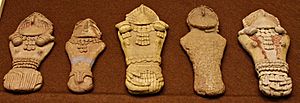Pilling Figurines facts for kids
The Pilling Figurines are a set of eleven small clay statues. They were made by the Fremont culture, an ancient Native American group. A rancher named Clarence Pilling found them in 1950. He discovered them under a rock in a canyon in Range Creek, Utah. These amazing figurines are thought to be about 1000 years old!
Contents
What Are the Pilling Figurines?
These figurines are small, about 4 to 6 inches tall. They are made from clay that wasn't baked. They have cool decorations made from extra pieces of clay. You can also see traces of red, buff (a yellowish-brown), and black paint on them.
These details help us learn how the ancient Fremont people dressed. Each figurine looks different and shows either a male or female figure. The female figurines have wider hips and wear aprons. The male figurines wear loincloths, except for one that wears a type of kilt.
It looks like they were made in matching male and female pairs. There is one extra female figurine. These figurines are considered very important ancient art. They are some of the best examples found in the Southwest. Today, all eleven figurines can be seen at the USU Eastern Prehistoric Museum.
The Mystery of Figurine Number 2
After Clarence Pilling found the figurines in 1950, they went to the USU Eastern Prehistoric Museum in Price. In the 1960s, the museum took the figurines on a tour across Utah. During this tour, one of the figurines, known as Number 2, disappeared!
It's not clear exactly when it went missing. Only ten figurines came back to the museum after the tour. At first, no one noticed it was gone. This was because another figurine had broken into two pieces. So, the museum still had 11 pieces in total.
How Figurine Number 2 Was Found
The location of Figurine Number 2 remained a secret for many years. Then, in November 2011, something amazing happened. Bonnie Pitblado, an anthropologist from Utah State University, received a package in the mail. Inside was a clay figurine! It looked very much like the Pilling Figurines.
The package also contained a note. The note said that the person had gotten the figurine between 1978 and 1982. They had received it from someone who said they found it near Vernal, Utah. The person who sent it wanted to return it to its rightful place.
Confirming the Missing Figurine
Dr. Pitblado immediately wanted to know if this was the long-lost Pilling Figurine. She worked with a team of experts. They carefully studied the figurine. They compared it to the ten figurines already at the museum. They wanted to make sure it was real and not a copy.
The team used special scientific tests. They used a scanning electron microscope to look for polyvinyl alcohol (PVA). This was a special liquid used to preserve all 11 original figurines. They also used a technique called X-ray fluorescence. This helped them find out where the clay came from. The clay matched the original ten figurines.
Experts also compared how the figurines were made. This showed that the same artist likely made them all. All these results confirmed it! The figurine sent in the mail was indeed the missing Number 2. It was a happy reunion for the Pilling Figurines!



